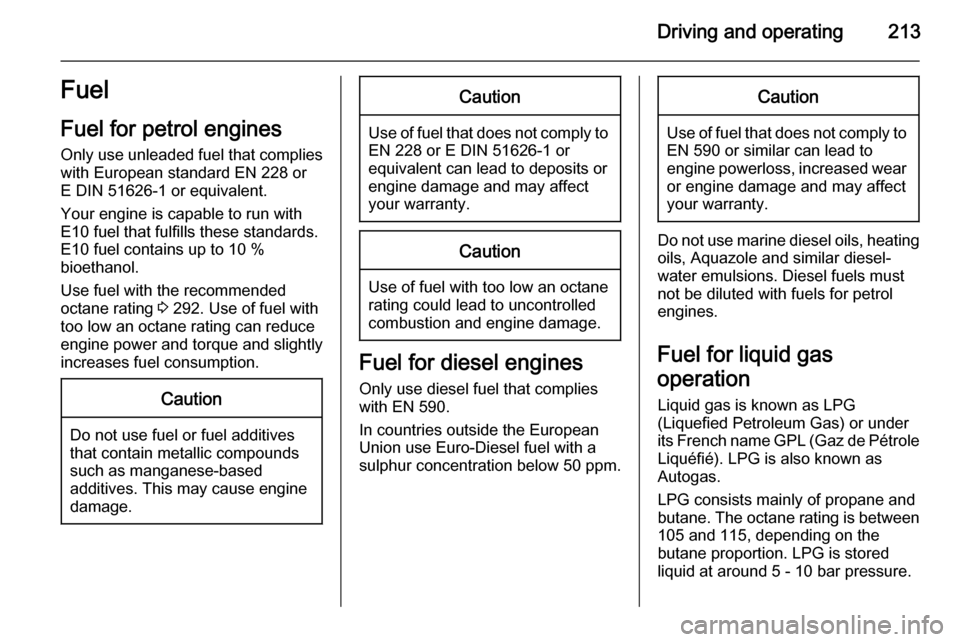torque OPEL ASTRA J 2014 Manual user
[x] Cancel search | Manufacturer: OPEL, Model Year: 2014, Model line: ASTRA J, Model: OPEL ASTRA J 2014Pages: 331, PDF Size: 10.13 MB
Page 168 of 331

166Driving and operating
Do not operate the accelerator pedal.Diesel engine: turn the key to position2 for preheating until control
indicator ! extinguishes.
Turn the key briefly to position 3 and
release: an automatic procedure
operates the starter with a short delay
as long as the engine is running, see
Automatic Starter Control.
Before restarting or to switch off the
engine, turn the key back to position
0 .
During an Autostop, the engine can
be started by depressing the clutch
pedal.Starting the vehicle at low
temperatures
The start of the engine without
additional heaters is possible down to -25 °С for diesel engines and -30 °C
for petrol engines. Required is an engine oil with the correct viscosity,
the correct fuel, performed services
and a sufficiently charged battery.
With temperatures below -30 °C the
automatic transmission need a
warming phase of approx. 5 minutes.
The selector lever must be in position P .
Automatic Starter Control
This function controls the engine
starting procedure. The driver does
not have to hold the key in position 3.
Once applied, the system will go on
starting automatically until the engine
is running. Because of the checking
procedure, the engine starts running
after a short delay.Possible reasons for a non-starting
engine:
■ Clutch pedal not operated (manual transmission)
■ Brake pedal not operated or selector lever not in P or N
(automatic transmission)
■ Timeout occurred
Turbo engine warm-up
Upon start-up, engine available
torque may be limited for a short time, especially when the engine
temperature is cold. The limitation is
to allow the lubrication system to fully
protect the engine.
Overrun cut-off The fuel supply is automatically cut off
during overrun, i.e. when the vehicle
is driven with a gear engaged but accelerator is released.
Page 215 of 331

Driving and operating213Fuel
Fuel for petrol engines Only use unleaded fuel that complies
with European standard EN 228 or
E DIN 51626-1 or equivalent.
Your engine is capable to run with
E10 fuel that fulfills these standards.
E10 fuel contains up to 10 %
bioethanol.
Use fuel with the recommended
octane rating 3 292. Use of fuel with
too low an octane rating can reduce
engine power and torque and slightly
increases fuel consumption.Caution
Do not use fuel or fuel additives
that contain metallic compounds
such as manganese-based
additives. This may cause engine
damage.
Caution
Use of fuel that does not comply to EN 228 or E DIN 51626-1 or
equivalent can lead to deposits or
engine damage and may affect
your warranty.
Caution
Use of fuel with too low an octane
rating could lead to uncontrolled combustion and engine damage.
Fuel for diesel engines
Only use diesel fuel that complies
with EN 590.
In countries outside the European
Union use Euro-Diesel fuel with a
sulphur concentration below 50 ppm.
Caution
Use of fuel that does not comply to EN 590 or similar can lead to
engine powerloss, increased wear
or engine damage and may affect
your warranty.
Do not use marine diesel oils, heating
oils, Aquazole and similar diesel-
water emulsions. Diesel fuels must
not be diluted with fuels for petrol
engines.
Fuel for liquid gas
operation
Liquid gas is known as LPG
(Liquefied Petroleum Gas) or under
its French name GPL (Gaz de Pétrole Liquéfié). LPG is also known as
Autogas.
LPG consists mainly of propane and
butane. The octane rating is between
105 and 115, depending on the
butane proportion. LPG is stored
liquid at around 5 - 10 bar pressure.
Page 273 of 331

Vehicle care271
Set the jack to the necessary
height. Position it directly below
the jacking point in a manner that
prevents it from slipping.
Attach jack handle and with the
jack correctly aligned rotate handle until wheel is clear of theground.
Sports Tourer, jack variant 2,
3 258:
Set the jack to the necessary
height. Position it directly below
the jacking point in a manner that
prevents it from slipping.
Attach wheel wrench and with the
jack correctly aligned rotate wheel wrench until wheel is clear of the
ground.
5. Unscrew the wheel nuts. 6. Change the wheel. Spare wheel 3 272.
7. Screw on the wheel nuts.
8. Lower the vehicle and remove jack.
9. Install the wheel wrench ensuring that it locates securely and tighten
each nut in a crosswise
sequence. Tightening torque is
140 Nm.
Page 274 of 331

272Vehicle care
10. Align the valve hole in the wheelcover with the tyre valve before
installing.
Install wheel nut caps.
Install centre cap on alloy wheels.
11. Install vehicle jacking point cover on versions with sill panelling.
12. Stow the replaced wheel 3 272
and the vehicle tools 3 258.
13. Check the tyre pressure of the installed tyre and the wheel nut
torque as soon as possible.
Have the defective tyre renewed or
repaired as soon as possible.Jacking position for lifting
platform
Rear arm position of the lifting
platform centrically under the recess
of the sill.
Front arm position of the lifting
platform at the underbody.
Spare wheel Some vehicles are equipped with a
tyre repair kit instead of a spare
wheel.
A spare wheel can be classified as a
temporary spare wheel depending on the size compared to the other
mounted wheels and country
regulations.
The spare wheel has always a steel
rim.
Page 294 of 331
![OPEL ASTRA J 2014 Manual user 292Technical dataEngine dataSales designation1.41.41.41.41.61.61.6Engine identifier codeA14XELA14XERA14NELA14NET LPGA16XERA16LETA16XHTNumber of cylinders4444444Piston displacement [cm3
]13981398136413 OPEL ASTRA J 2014 Manual user 292Technical dataEngine dataSales designation1.41.41.41.41.61.61.6Engine identifier codeA14XELA14XERA14NELA14NET LPGA16XERA16LETA16XHTNumber of cylinders4444444Piston displacement [cm3
]13981398136413](/img/37/18768/w960_18768-293.png)
292Technical dataEngine dataSales designation1.41.41.41.41.61.61.6Engine identifier codeA14XELA14XERA14NELA14NET LPGA16XERA16LETA16XHTNumber of cylinders4444444Piston displacement [cm3
]1398139813641364159815981598Engine power [kW]64748810385132125at rpm600060004200-60004900-6000600055006000Torque [Nm]130130200200155230260at rpm400040001850-42001850-4900400022001650-3200Fuel typePetrolPetrolPetrolPetrol/LPGPetrolPetrolPetrolOctane rating RONrecommended95959595959598possible98989898989895possible91919191919191Gas–––LPG–––Oil consumption [l/1000 km]0.60.60.60.60.60.60.6
Page 295 of 331
![OPEL ASTRA J 2014 Manual user Technical data293
Sales designation1.82.0 OPC1.31.71.71.7Engine identifier codeA18XERA20NFTA13DTEA17DTEA17DTCA17DTFNumber of cylinders444444Piston displacement [cm3
]179619981248168616861686Engine pow OPEL ASTRA J 2014 Manual user Technical data293
Sales designation1.82.0 OPC1.31.71.71.7Engine identifier codeA18XERA20NFTA13DTEA17DTEA17DTCA17DTFNumber of cylinders444444Piston displacement [cm3
]179619981248168616861686Engine pow](/img/37/18768/w960_18768-294.png)
Technical data293
Sales designation1.82.0 OPC1.31.71.71.7Engine identifier codeA18XERA20NFTA13DTEA17DTEA17DTCA17DTFNumber of cylinders444444Piston displacement [cm3
]179619981248168616861686Engine power [kW]10320670818196at rpm630053004000400040004000Torque [Nm]175400190280280300at rpm38002400-48001750-32501750-25001750-25002000-2500Fuel typePetrolPetrolDieselDieselDieselDieselOctane rating RONrecommended9598possible9895possible9191Oil consumption [l/1000 km]0.60.60.60.60.60.6
Page 296 of 331
![OPEL ASTRA J 2014 Manual user 294Technical data
Sales designation1.72.0 Turbo2.0 TurboEngine identifier codeA17DTSA20DTHA20DTRNumber of cylinders444Piston displacement [cm3
]168619561956Engine power [kW]96121143at rpm400040004000T OPEL ASTRA J 2014 Manual user 294Technical data
Sales designation1.72.0 Turbo2.0 TurboEngine identifier codeA17DTSA20DTHA20DTRNumber of cylinders444Piston displacement [cm3
]168619561956Engine power [kW]96121143at rpm400040004000T](/img/37/18768/w960_18768-295.png)
294Technical data
Sales designation1.72.0 Turbo2.0 TurboEngine identifier codeA17DTSA20DTHA20DTRNumber of cylinders444Piston displacement [cm3
]168619561956Engine power [kW]96121143at rpm400040004000Torque [Nm]300350400at rpm2000-25001750-25001750-2500Fuel typeDieselDieselDieselOil consumption [l/1000 km]0.60.60.6